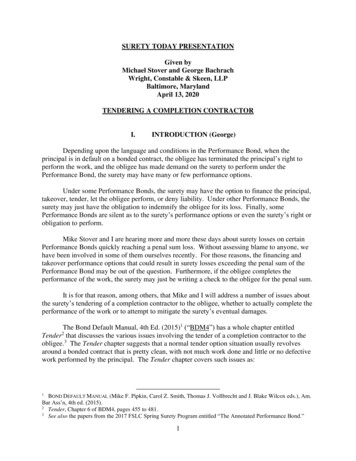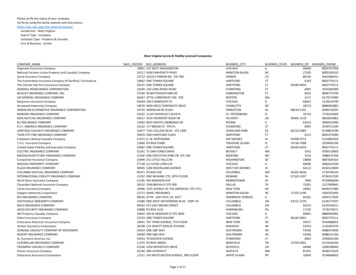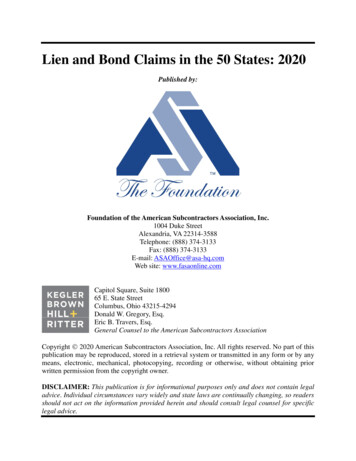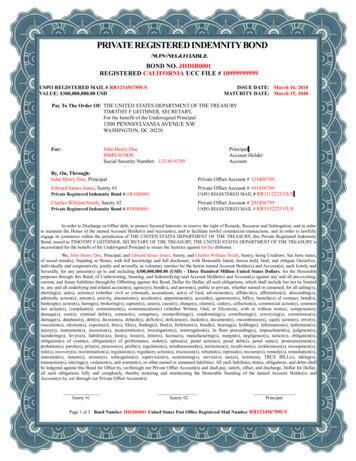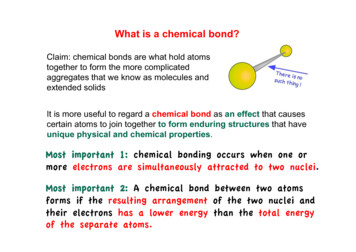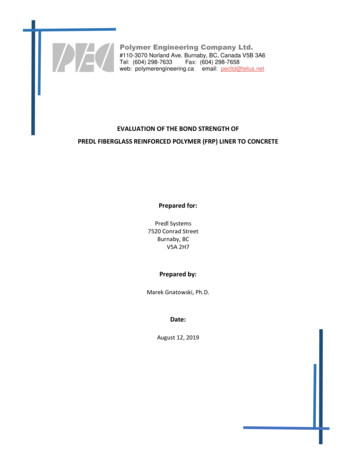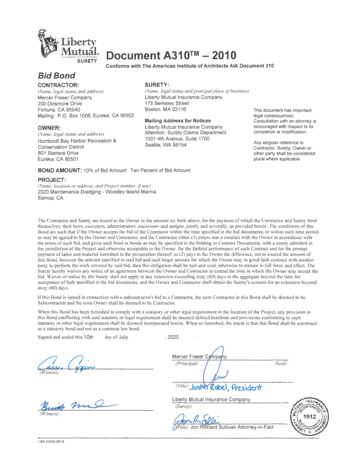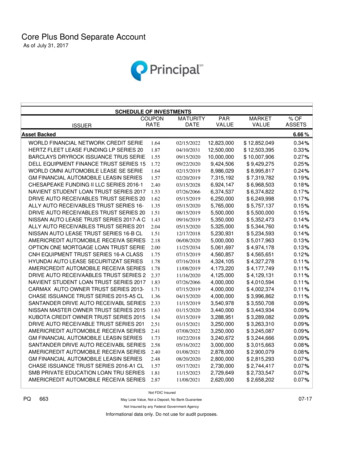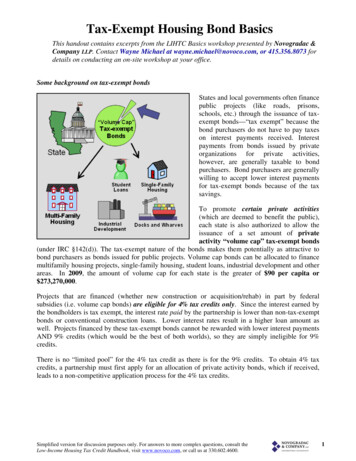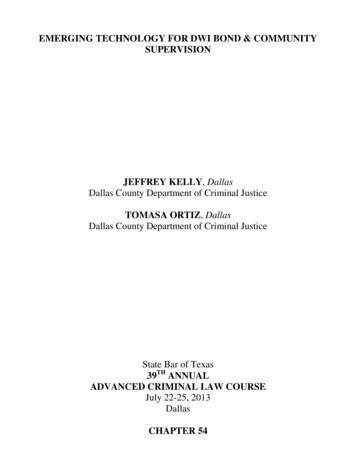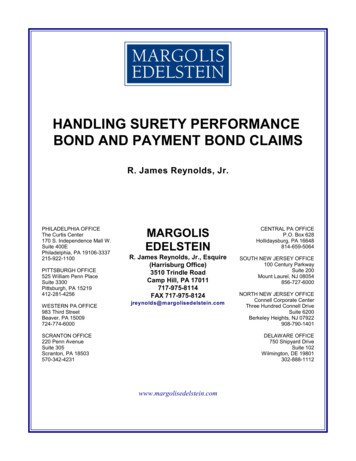
Transcription
HANDLING SURETY PERFORMANCEBOND AND PAYMENT BOND CLAIMSR. James Reynolds, Jr.PHILADELPHIA OFFICEThe Curtis Center170 S. Independence Mall W.Suite 400EPhiladelphia, PA 19106-3337215-922-1100PITTSBURGH OFFICE525 William Penn PlaceSuite 3300Pittsburgh, PA 15219412-281-4256WESTERN PA OFFICE983 Third StreetBeaver, PA 15009724-774-6000MARGOLISEDELSTEINR. James Reynolds, Jr., Esquire(Harrisburg Office)3510 Trindle RoadCamp Hill, PA 17011717-975-8114FAX 717-975-8124jreynolds@ margolisedelstein.comSCRANTON OFFICE220 Penn AvenueSuite 305Scranton, PA 18503570-342-4231CENTRAL PA OFFICEP.O. Box 628Hollidaysburg, PA 16648814-659-5064SOUTH NEW JERSEY OFFICE100 Century ParkwaySuite 200Mount Laurel, NJ 08054856-727-6000NORTH NEW JERSEY OFFICEConnell Corporate CenterThree Hundred Connell DriveSuite 6200Berkeley Heights, NJ 07922908-790-1401DELAWARE OFFICE750 Shipyard DriveSuite 102Wilmington, DE 19801302-888-1112www.margolisedelstein.com
TABLE OF CONTENTSPageI.Introduction1II.Performance Bonds2III.Payment Bonds20
I.IntroductionA.What is a surety bond?1.A surety bond is a three-party agreement between the principal, theobligee, and the surety in which the surety agrees to uphold, for the benefit of the obligee, thecontractual obligations of the principal if the principal fails to do so.2.If the principal fulfills its contractual obligations, the surety's obligationis void. However, if the principal defaults on the underlying contract, the obligee can make a claimagainst the surety under the surety bond.3.Suretyship is distinguishable from insurance. Suretyship is not a formof insurance. The suretyship relationship is a three-party relationship (surety, principal and obligee).In an insurance contract, there are only two parties (insurer and insured).4.In an insurance relationship, the insurer undertakes to indemnify theinsured against loss as a result of an unknown or contingent event. In a suretyship relationship, thesurety undertakes to answer for the debt or default of the principal.B.Who are the three parties to a surety bond?1.Principal - the principal is the primary obligor who performs thecontractual obligations (e.g. the contractor on a construction project).2.Obligee - the obligee is the entity that enters into the contract with theprincipal and is the recipient of the obligations (e.g. the governmental unit on a construction project).3.Surety - the surety is the secondary obligor which guarantees that theprincipal's obligations will be performed.C.What are the types of surety bonds?There are two main types:1.Contract Surety Bonds - They guarantee a specific contract andinclude: (a) performance bonds (discussed in Section II below); (b) payment bonds (discussed inSection III below); and (c) bid bonds.2.Commercial Surety Bonds - They guarantee the terms of the bond,rather then a specific contract, and include: (a) license and permit bonds (e.g. motor vehicle dealerbonds; (b) notary bonds; and (c) other types of miscellaneous bonds- public official bonds, fuel taxbonds, etc.-1-
D.What is the penal sum of the surety bond?1.The penal sum is the maximum amount set forth in the bond whichthe surety will be required to pay in the event of the principal's default.2.Generally, the penal sum is the amount of the contract entered intobetween the principal and the obligee.E.What are the surety's rights of indemnity?1.In consideration for issuing bonds on behalf of the principal, the suretywill generally require the principal, individuals with an ownership interest in the principal entity (andtheir spouses), and related entities to execute an Indemnity Agreement in favor of the surety which,among other things, requires the indemnitors to indemnify/reimburse the surety for all losses andexpenses (including attorney's fees, consultant's fees, and court costs) that the surety incurs as a resultof issuing the bonds.2.If the surety pays a claim under a surety bond, it can seekindemnification/reimbursement from the principal and the indemnitors who have signed anIndemnity Agreement in favor of the surety.II.Performance BondsA.Purpose of performance bonds1.A performance bond protects the owner against the risk of default ona construction contract.2.A performance bond provides available funds to complete theprincipal's contract should the principal be in default of the performance that is owed to the obligee.3.The surety's obligation tracks that of the principal under the bondedcontract up to the penal sum of the bond, subject to the specific terms and limitations in the bond,and is conditioned upon the principal's material default of its performance obligations under thebonded contract.B.Parties to performance bonds1.There are three parties: the principal (typically the general contractor)who has assumed a contractual undertaking; the obligee (typically the project owner) who is entitledto the benefits of the principal's performance; and the surety who provides a performance bond thatsecondarily guarantees to the obligee performance of the principal's contractual undertaking.-2-
2.If the surety pays an obligee under the performance bond, it is entitledto be indemnified for its loss pursuant to a written indemnity agreement, which is part of theconsideration for issuing the bond.C.Types of performance bonds1.Federal Miller Act Bonds(a)Before any contract of more than 100,000 is awarded for theconstruction, alteration or repair of any public building or public work of the federal government,a performance bond must be furnished. 40 U.S.C. § 3131(b)(1).(b)The performance bond shall be in an amount the contracting officerconsiders to be adequate for the protection of the Government, including coverage for taxes. 40U.S.C. § 3131(b)(1).(c)The Miller Act does not prescribe the form of the requiredperformance bond, but the Code of Federal Regulations provides a standard form, Federal StandardForm 25 Performance Bond, that is commonly used.2.State Public Works (Little Miller Act) Bonds(a)All states have public work statutes that require contractors that areawarded contracts on state public projects to provide performance bonds.(b)These statutes are often referred to as "Little Miller Acts," since mostof them contain provisions that are similar to the Miller Act.3.Pennsylvania Little Miller Act Bonds(a)The statutory bonding requirements for Pennsylvania public worksprojects are set forth in the Pennsylvania Public Works Contractors' Bond Law of 1967, 8 P.S. §§191 et seq. ("PA Bond Law") and in Part I of the Commonwealth Procurement Code, 62 Pa. C.S.A.§§ 101 et seq. ("PA Procurement Code"), which was enacted in 1998.(b)Prior to the adoption of the PA Procurement Code in 1998, the PABond Law was the controlling statute with regard to bond requirements for all public bodies inPennsylvania.(c)As a result of the enactment of the PA Procurement Code, the PABond Law only applies to public projects that are not with Commonwealth purchasing agencies (e.g.municipalities, school districts, municipal authorities, etc.). The PA Procurement Code applies topublic contracts with a Commonwealth purchasing agency.-3-
(d)For projects subject to the PA Bond Law (contracts exceeding 10,000for the construction, reconstruction, alteration or repair of any public work not with aCommonwealth purchasing agency), a contractor must furnish to the contracting body a performancebond in the amount of 100% of the contract amount, conditioned upon the faithful performance ofthe contract in accordance with the plans, specifications and conditions of the contract. 8 P.S. §193.1(a)(1).(e)For projects subject to the PA Procurement Code involving contractsbetween 25,000 and 100,000, the contractor must provide a performance bond or other acceptablesecurity in an amount equal to at least 50% of the contract price as the purchasing agency, in itsdiscretion, determines is necessary to protect the interests of the Commonwealth. 62 Pa. C.S.A. §903(a).(f)For projects subject to the PA Procurement Code involving contractsin excess of 100,000, the contractor must provide a performance bond or other acceptable securityin an amount equal to 100% of the contract price. 62 Pa. C.S.A. § 903(a)(1).(g)Both the PA Bond Law and the PA Procurement Code provide thatthe performance bond shall be solely for the protection of the purchasing agency which awarded thecontract. 8 P.S. § 193.1(a)(1); 62 Pa. C.S.A. § 903(b).4.Private Project Bonds(a)An owner on a private project may require a contractor to provide aperformance bond for a construction project even though it is not required by statute.(b)No statutes in the Commonwealth of Pennsylvania requireperformance bonds on private projects.(c)Performance bonds on private projects vary in form and need to beexamined carefully to determine the rights of the parties.5.AIA Bonds(a)The American Institute of Architects ("AIA") has drafted several typesof performance bonds to be utilized by owners on construction projects (both public and private),including the AIA A312 performance bond and the AIA A311 performance bond. (Note: The A311bond is the predecessor to the A312 bond, but it is still in use).D.Conditions precedent to asserting a performance bond claim1.Possible conditions precedent under performance bond forms that arecommonly in use include the following:-4-
(a)under the bonded contract;(b)the obligee is required to comply with its obligations to the contractorthe obligee is required to hold a pre-default meeting;(c)the obligee is required to formally default the principal and terminateits right to complete the contract;(d)the obligee is required to give notice to the surety of the default andtermination of its principal so that the surety has an opportunity to select its preferred performanceor completion option;(e)the obligee is required to dedicate the undisbursed contract balanceto the completion of the bonded contract.2.Most performance bonds are "defeasance" bonds in that they statethat the bond obligation is null and void if the contractor performs in conformance with the termsand conditions of the contract. Otherwise, the bond obligation remains in full force and effect.(a)The rights and obligations of the surety and the obligeepursuant to a defeasance bond depend upon the specific provisions in the bond form being utilized.(b)Two widely used defeasance bond forms are the A312Performance Bond and the A311 Performance Bond.3.Conditions precedent under A312 Performance Bond (1984 version) The surety's obligation arises only if:(a)the obligee is not in default;(b)the obligee notifies the contractor and the surety that it isconsidering declaring a default;(c)the obligee requests and attempts to arrange a conferencewith the contractor and the surety not later than 15 days after receipt of the notice;(d)following the conference, the obligee declares a default andformally terminates the contractor's right to perform (at least 20 days after receipt of the notice ofdefault); and(e)the obligee agrees to pay the contract balance to the surety ora contractor selected to take over performance.-5-
4.Conditions precedent under A312 Performance Bond (2010 version):(a)Although similar to the 1984 form, the 2010 form contains amore streamlined process for the obligee to make a claim based upon the contractor's default.(b)The 2010 form does not require a conference, but allows thesurety to request that a conference be held within 10 days of receipt of the obligee's notice;(c)The 2010 form provides that the obligee's failure to complywith the notice requirements shall not release the surety from its obligations except to the extent thesurety can demonstrate actual prejudice.(d)The 2010 form still provides that the surety's obligation underthe Bond does not arise until: (1) the obligee provides notice to the contractor and surety that it isconsidering declaring a contractor default; (2) after the time period for requesting and holding aconference expires, the obligee declares a default and terminates the contract; and (3) the obligee hasagreed to pay the balance of the contract price to the surety or to a contractor selected to completethe contract.5.than A312 bond):Conditions precedent under A311 Performance Bond (less detailed(a)the principal is in default;(b)the obligee declares the contractor to be in default; and(c)the obligee has performed its obligations under the underlyingcontract. L&A Contracting Co. v. Southern Concrete Services, Inc., 17 F. 3d 106 (5th Cir. 1996).6.Conditions precedent under Federal Standard Form 25 PerformanceBond. The surety's obligation arises if:(a)the principal fails to: (1) fulfill "all the underlying, covenants,terms, conditions, and agreements" of the contract with the obligee and any modifications to thecontract during the original term of the contract and any extensions granted by the government, andduring the life of any guaranty required under the contract and (2) pay to the government the fullamount of the taxes imposed by the government (e.g. taxes collected, deducted or withheld fromwages).(b)E.Otherwise, the surety's obligation under the bond is void.Surety's performance options-6-
1.Surety's investigation(a)A surety's first obligation upon receiving a performance bond claimis to commence an investigation of the claim.(b)The surety's investigation is a fact-finding exercise intended topromptly determine whether the bond principal is in default of its contractual obligations and if so,whether the surety has liability under the performance bond.(c)Because the surety's investigation will determine its response to theclaim, it is important that the surety conduct the investigation in an expeditious and comprehensivemanner and gather as much information as is reasonably available.(d)In making its investigation, the surety should gather information fromas many sources as possible including the surety's own files, the obligee, and the bond principal.(e)After receiving a notice of a claim from the obligee, the suretyshould acknowledge the claim, request further documentation to substantiate the claim, and reserveits rights and defenses.(f)The surety should also send a letter to the principal and theindemnitors under the Agreement of Indemnity, notifying them of the claim, of the surety's exposureto potential losses under the bonds issued on behalf of the principal, of the principal's duty tocooperate with the surety during its investigation of the claim, and of their indemnity obligationsunder the Agreement of Indemnity.2.Under many performance bonds, before a surety is required toact, the obligee must formally declare the principal in default of its contractual obligations.(a)Depending upon the bond form and its interpretation by the courts, anobligee's failure to comply with the bond provisions or the underlying contract terms incorporatedby reference under the bond for declaring a principal in default may discharge or exonerate thesurety's liability. L & A Contracting Co. v. Southern Concrete Services, Inc., 17 F.3d 106 (5th Cir.1994).(b)When the bond does not require the obligee to declare adefault and the obligee has not terminated the principal, but the surety has been advised that theprincipal is in default of its bonded obligations, it may be prudent for the surety to begin itsinvestigation.F.Surety's use of construction consultants1.A construction consultant is an engineer or construction manager who-7-
specializes in project and construction management.2.At the preliminary stage of the bond default process, the constructionconsultant can furnish information such as the following:(a)the percentage of completion of the principal's work;(b)the quality of the work;(c)the projected completion date;(d)estimates of the cost to complete the work, either by theprincipal or another contractor; and(e)the identification and analysis of claims made by the principal,the obligee, or subcontractors.3.If the surety decides to procure bids for the completion of the contract,the construction consultant will put together the bid package and evaluate the bids.4.consultant will:If the surety takes over the completion of the work, the construction(a)monitor the completion of the work by the completion(b)approve requisitions for payment submitted by the completion(c)act as a liaison between the obligee and the obligee's projectcontractor;contractor; andrepresentative.5.Generally, a surety needs a consultant whenever the surety's ownpersonnel lack the skill, knowledge or expertise to perform the investigation.G.Surety's use of other consultants1.Legal consultants to provide services in the following areas:(a)available to the surety;(b)the identification and evaluation of defenses that may bethe interpretation of legal documents;-8-
(c)the drafting of documents relating to the bond default,including takeover agreements, completion agreements, tender agreements, tri-party agreements, etc.(d)the handling of litigation that arises from the bond default, suchas claims against performance bonds and payment bonds, and recovery actions against the principaland indemnitors;(e)participation in meetings and negotiations related to the bond(f)miscellaneous services.default;2.Accounting consultants to provide services related to ascertaining theprincipal's financial condition to enable the surety to determine its exposure to loss fromthe bond default and to enable the surety to assess which option it should choose to respond to thedefault.3.Technical consultants to advise the surety on specialized issues ofengineering that may arise in connection with a bond default. For example:(a)If there was a structural failure on the project, the surety mayneed to retain a structural engineer to analyze the adequacy of the design.(b)A surety may need to retain an architect to review thecompetency with which the plans and specifications for the project were prepared.H.Surety's performance options1.Once the surety completes its investigation, it must decide the mostappropriate means of responding to the performance bond claim.2.Generally the surety has six options:(a)take over and complete the project;(b)tender a new contractor;(c)finance the bond principal's completion of the work;(d)indemnify the obligee;(e)buy out the bond obligation; or-9-
(f)I.deny the claim.Takeover and completion of project1.The surety usually has the opportunity to enter into a takeoveragreement with the obligee under which the surety agrees to complete the project using a completioncontractor.2.The surety will also need to enter into a completion agreement withthe completion contractor.3.The advantages of this option are:(a)It allows the surety to control completion costs.(b)The surety can select a qualified completion contractor at acompetitive price.(c)This option can be attractive when the project is close tocompletion, and completion by the principal is no longer possible.(d)The obligee may not be willing to accept a tender, andtherefore the takeover option may be the only viable alternative.4.The disadvantages of this option are:(a)The surety is in a direct contract with the obligee to completethe project, and the surety must see the contract to completion despite any problems that areencountered.(b)The risk to the surety is unknown.(c)Once a surety undertakes to complete the work, its ultimateliability will no longer be limited by the penal sum of the bond unless the takeover agreement limitsthe surety's liability to the penal sum of the bond. However, the obligee is under no obligation toagree to such a limiting provision.5.In negotiating the Takeover Agreement, the surety should attempt toobtain a waiver from the obligee of liquidated damages and an agreement that the surety's liabilityis limited to the penal sum of the bond.J.Tender of completion contractor-10-
1.The surety can attempt to fulfill its performance bond obligations by:(a)obtaining bids from contractors to complete the work;(b)tendering the low bidder to the obligee;(c
5. AIA Bonds (a ) The Ame rica n I nstitu te o f A rc hitec ts (" AIA") has dra ft ed sever al ty pes of performance bonds to be utilized by owners on construction projects (both public and private), including the AIA A312 per formanc e bond and the AIA

